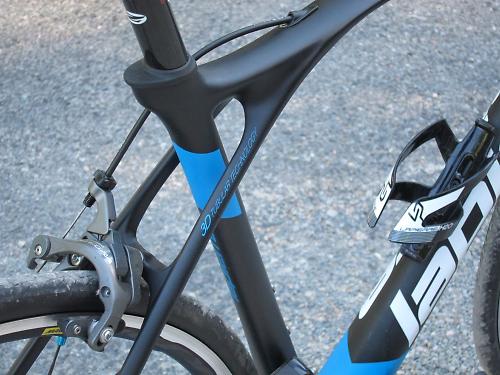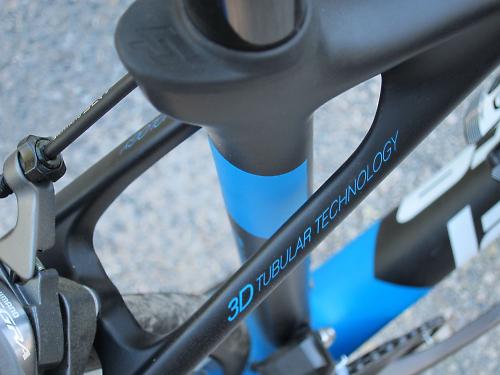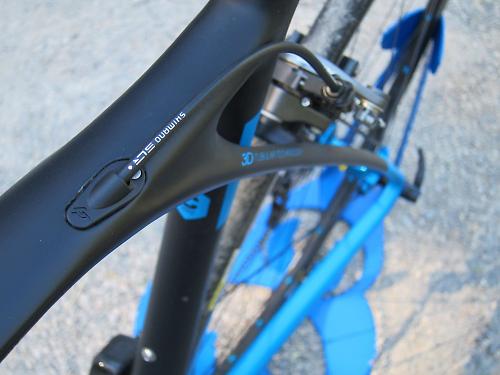- News
- Reviews
- Bikes
- Accessories
- Accessories - misc
- Computer mounts
- Bags
- Bar ends
- Bike bags & cases
- Bottle cages
- Bottles
- Cameras
- Car racks
- Child seats
- Computers
- Glasses
- GPS units
- Helmets
- Lights - front
- Lights - rear
- Lights - sets
- Locks
- Mirrors
- Mudguards
- Racks
- Pumps & CO2 inflators
- Puncture kits
- Reflectives
- Smart watches
- Stands and racks
- Trailers
- Clothing
- Components
- Bar tape & grips
- Bottom brackets
- Brake & gear cables
- Brake & STI levers
- Brake pads & spares
- Brakes
- Cassettes & freewheels
- Chains
- Chainsets & chainrings
- Derailleurs - front
- Derailleurs - rear
- Forks
- Gear levers & shifters
- Groupsets
- Handlebars & extensions
- Headsets
- Hubs
- Inner tubes
- Pedals
- Quick releases & skewers
- Saddles
- Seatposts
- Stems
- Wheels
- Tyres
- Health, fitness and nutrition
- Tools and workshop
- Miscellaneous
- Tubeless valves
- Buyers Guides
- Features
- Forum
- Recommends
- Podcast
TECH NEWS
First look at Lapierre’s new Xelius SL and Aircode SL race bikes
Dijon-based bicycle manufacturer Lapierre has put its flagship race bikes on a diet for 2016, with the launch of the redesigned Xelius SL and lighter Aircode SL models unveiled at a launch event in the beautiful Le Rozier village in the Languedoc-Roussillon region of France early last week.
Lapierre has made the most of its 14-year ongoing sponsorship of the FDJ.fr professional team and used them to help develop these new bikes. The design process for the two new bikes started with establishing the requirements of the team, finding out what they wanted from the bikes, before setting about developing and testing the new bikes in the lab and then on the road.
The new bikes have already been spotted between the legs of some racers on the FDJ.fr professional team, so if you’ve been watching closely you might have glimpsed one of these new bikes already.
Xelius SL
Let’s start with the Xelius SL, because it’s the bike that has had the most significant update of the two new models. This is the go-to race bike when weight and stiffness are the most important criteria, ideal for climbing. Changes to the tube profiles and carbon layup have reduced the frame weight, for a 54cm, to a claimed 850g.

The most radical solution to achieving the lower weight over the previous frame is the way the seat stays wrap around the seat tube, without touching it, and terminate at the top tube. There’s a hint of GT’s iconic Triple Triangle about it, but there’s well thought out engineering reasoning behind the design.

Lapierre engineer Rémi Gribaudo (one of seven engineers working on these new bikes) told us the design was a solution to the desire to reduce frame weight, and particular weight in the top half of the frame. By extending the seat stays all the way up to the top tube, less material is needed to reinforce the conventional seat stay and seat tube junction design of the previous Xelius.

The seat stays aren’t attached to the seat tube at all, instead flowing smoothly into the top tube. Comfort (the seat tube visibly flexes when weight is applied through the saddle) wasn’t a consideration in the design process but a desirable side benefit of the design.

Another interesting development of the new Xelius SL has been the desire to lower the centre of gravity. By removing as much weight from the top half of the frame as possible, and the development of its Trap Door Technology (TPT) which locates the Shimano Di2 battery in the belly of the down tube in a special compartment, rather than in the seatpost, Lapierre reckons that handling, whether it's climbing out of the saddle or railing turns, has been improved. They tested the bike on a treadmill and the feedback from the team is that the new Xelius SL is a more responsive handling bike.

The Xelius SL also features a fork with a recessed section for the direct-mount front brake to sit in, a design feature borrowed from the Aircode SL. It's a regular dual pivot rear brake caliper. Other details worth mentioning include the full internal cable routing, 27.2mm seatpost, integrated seat clamp and tapered head tube. There are now six frame sizes as opposed to five last year.
Review: Lapierre Xelius EFi 200 road bike

Save for 3mm shorter chainstays (now 405mm) the geometry of the Xelius SL is identical to the previous incarnation. As a bike developed for a race team, the geometry chart shows very aggressive numbers, as you’d expect.

The Xelius SL will be available in three builds (Shimano 105, Ultegra and Ultegra Di2) and the Ultimate custom programme will allow a plethora of specification changes. Lapierre hasn’t confirmed UK prices yet, and availability is expected to be July.
Aircode SL
The Aircode SL has undergone a less dramatic update than the new Xelius SL. It retains the same frame shape and styling of the first Aircode which was only released a year ago, but it has undergone a bit of weight loss - the frame is 90g lighter and the new fork saves 20g, making frame weight 960g for a size 54cm. Despite this weight loss, there has been no drop in frame stiffness according to Lapierre.

Aero road bikes used to carry quite a weight penalty compared with regular road bikes, but that gap has been narrowing all the time. Lapierre wanted to get the weight of the new Aircode SL closer to its Xelius SL for the primary reason that it would be easier for the FDJ.fr pros to choose between the two models. While 110g will still concern the weight weenies, for many racers it's a small enough difference that making the decision to ride the aero bike might now be a bit easier.

To achieve the weight loss Lapierre has modified the layup of the carbon fibres. It uses a combination of 30, 38 and 40 ton modulus carbon fibre and has reduced the number of layers used in the head tube, while in the seat tube the layers are now shorter, to help lower the weight.

The updated Aircode SL retains the same aerodynamic tube profiles as its predecessor. The down tube and seat tube use a kamm tail profile (a teardrop with a chopped tail), there’s an integrated seat clamp and all cable routing is internal. Unusually, it has a round seatpost rather than an aero post.

Lapierre has developed PowerBox technology for the Aircode SL, which comprises the lower half of the frame being built to be as stiff as possible, while the top half of the frame is designed to provide comfort. This is a common design direction we’re seeing on many top-end road race frames as manufacturers look to best balance the demands of stiffness and comfort.

Lapierre has used a direct-mount front brake caliper and it's recessed into the fork blades. There’s a regular dual pivot rear brake caliper and it’s mounted on the seat stays now, rather than under the chainstays as last year. Like the Xelius, there will be three complete Shimano builds to choose from, but prices haven’t been confirmed yet.
.jpg)
I had the opportunity to put the two new bikes through their paces while in France for the launch event and you’ll be able to read my first ride impressions soon. For now hit up www.lapierre-bikes.co.uk for more info.
David worked on the road.cc tech team from 2012-2020. Previously he was editor of Bikemagic.com and before that staff writer at RCUK. He's a seasoned cyclist of all disciplines, from road to mountain biking, touring to cyclo-cross, he only wishes he had time to ride them all. He's mildly competitive, though he'll never admit it, and is a frequent road racer but is too lazy to do really well. He currently resides in the Cotswolds, and you can now find him over on his own YouTube channel David Arthur - Just Ride Bikes.
Latest Comments
- Rendel Harris 2 sec ago
Condolences for the loss of your father. That's an Eddy Merckx EMX5 frameset, I would guess from the paint job about 2009. I'm no expert in...
- Circles 22 min 35 sec ago
Funny how so many drivers bring up the point that they pay for insurance, implying that cyclists should too. One has always been a legal...
- lio 26 min 12 sec ago
This sentence is flipping joke surely?...
- ktache 1 hour 23 min ago
It's only a couple of hours a week, doesn't seem that bad...
- Pub bike 1 hour 53 min ago
The London Borough of Wandsworth has taken to installing granite blocks for paving on raised crossings and even on off-camber junctions. They are...
- Rendel Harris 2 hours 12 min ago
Othering of those in non-conformist outgroups. Lists of persons regarded as "villains" to be hated by society. Language comparing targets to vermin...
- lesterama 4 hours 16 min ago
There's a big difference between 54/11 and 56/10. Just sayin'.
- Dr Watson 4 hours 30 min ago
I’ll be playing all year again if it’s on. Pleeease.
- chrisonabike 8 hours 11 min ago
It would have to be the police's cars... although stealing bikes from a police station does seem to fall in to the "low hanging fruit" bracket for...
- Hirsute 9 hours 25 min ago
13 vehicles crashed through my wall. https://www.bbc.co.uk/news/articles/clyvegw54e5o Time for some proper bollards!
































































Add new comment
3 comments
The Xelius frame is stunning, but the fork is another matter... Hope they use similar design on Sensium frame in due course ...would be very tempted.
I wonder what has been the quickest dropped fad in cycling, under the chainstays mounted brakes are definitely up there.
The Lapierres look good, too by the way.
Dropped bars on MTBs. Even John Tomac couldnt make that one stick!